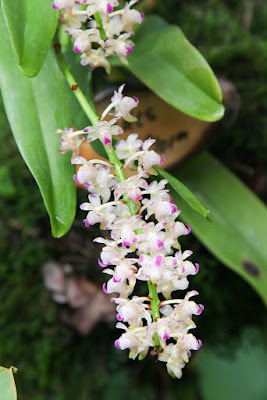Aerides multiflora was first described by William Roxburgh in 1820. The name is considered as validly published. It is native to Assam, Bangladesh, eastern Himalayas, India, Nepal, western Himalayas, Andaman Islands, Myanmar, Thailand, Laos, Cambodia and Vietnam in semi-deciduous and deciduous dry lowland tropical and subtropical forests at elevations of sealevel to 1100 meters.
Aerides multiflora orchid, also called as The Multi-Flowered Aerides, is a species of Aerides genus. Several synonyms are know for this species such as: "Aerides affinis Wall 1833"; "Aerides godefroyana Rchb.f 1886"; "Aerides lobbii Hort. ex Lem. 1868"; "Aerides multiflorum var dactyloides M Ahmed & Etal 1989"; "Aerides multiflorum var godefroyana [Rchb.f] AH Kent 1891"; "Aerides multiflorum var lobbii [Hort]Veitch"; "Aerides multiflorum var veitchii [De Puydt] Morr."; "Aerides trigona Klotsch 1855"; "Aerides veitchi De Puydt"; "Aerides veitchi R.H. Torr. ex E. Morren 1876"; "Cleisostoma vacherotiana Guillaumin 1948"; "Epidendrum geniculatum Hook.f. 1890".
IDENTIFY AERIDES MULTIFLORA ORCHID
Aerides multiflora was first described by William Roxburgh in 1820. The name is considered as validly published. It is native to Assam, Bangladesh, eastern Himalayas, India, Nepal, western Himalayas, Andaman Islands, Myanmar, Thailand, Laos, Cambodia and Vietnam in semi-deciduous and deciduous dry lowland tropical and subtropical forests at elevations of sea-level to 1100 meters.
It is a small to medium sized, hot to cool growing, monopodial orchid with a stout, many leafed stem, carrying ligulate, distichous, curved, bilobed apically leaves that is deeply channeled and keeled. Leaves about eight inches long, dark green, and covered with small spots.
Flowers of a white and pink colour, resembling so many small shells, so beautiful are they in appearance. Plant blooms from spring to summer with up to fifty 2.5 cm wide flowers on a a rarely branched, 12" (30 cm) long, pendulous, many (to 50) flowered inflorescence with waxy, fragrant flowers.
GROW AND CARE AERIDES MULTIFLORA ORCHID
If you buy Aerides multiflora orchid from the garden-house, you should choose the strong plants with more roots, and the leaf and stems without signs of fungal diseases. For wild orchids, you should choose the plants with intact leaves, not crushed, no rotten tops and remain at least 2 strong roots. Its recommended to choose the plants with straight stems to easier mounted.
When buying this species from the garden-house, it is best to hang it in a dry place, stop watering for 2 days and then water it again so that the plant will get familiar to the climate of your garden. For wild orchids, soak the plant in anti-fungus for 15 minutes and then hang back and irrigate the root stimulant. Remember to hang the plant in the cool place, avoid rain, and watering as soon as the plant is dry to quickly get new roots. Need to wait till the plant have new roots, then mounted.
Light, temperature and humidity:
Plants require bright to full sunlight and cool to warm temperatures. Hanging positions are important. If the tree is hanging at 70% sunny, when the stems and roots are still weak, the bottom leaves also fall. If hung 3m higher than the ground, with 70% sunshine, then after 1 year the plant will have 1-2 more leaves. If hanging from 1,8m higher than the ground, with 40-50% sunshine, the leaves are wetter, lighter and after one year the plant will have 2-4 more leaves.
Cultivate, growing medium:
Plants are best grown hanged in baskets and on mounted. Plants should be grown in media that is well drained such as tree fern fibers (for small plants), several pieces of coarse fir bark, or sphagnum moss. Early mounted, the plant should avoid rain to avoid rotten tops.
Watering:
Once the plants have grown well, they should be watered daily as soon as they are dry. Depending on the climate of each garden that choose the appropriate irrigation. Sunny season should be watered more often, the rainy season only irrigation when the substrate has dried.
Fertilizer:
When plants have more roots, should provide more fertilizer to grow faster, more fat. With wild orchids, the majority prefer organic fertilizer over inorganic fertilizers, but need to irrigate with dilute doses, can be used weekly organic fertilizers and 20-20-20 inorganic fertilizers once a month to help the plant balanced and increase resistance.
Pest control:
Aerides multiflora orchid is a species of wild orchid, so it has strong resistance, but still vulnerable to some fungus diseases such as drop leaf, rotten tops (especially the lack of open air in rainy season), red spider ... So we should spray anti-fungus such as carbendazim, alliet ... and red-spider-killer once a month.
Flowering:
This species usually flowers at the beginning of the rainy season after a long period of drought, so to plant flowers, we should choose the big plants, strong enough to flower, when the rainy season ends, we use 6-30-30 fertilizer 4 times at intervals of one week, reducing irrigation water from once a day to once every 2 days, then longer and stop irrigation, hung in a cool, little sun light to stimulates bud. Keep hang the plant until the early rains, when the plant have new shoots, water and spray root-simulant, use 20-20-20 fertilizer 3 times, each time a week to get more beautiful flowers.

















I've had one of these plants for 2 years now, and it's done nothing! No new roots, no new leaves, nothing. I felt that it was unhappy in it's clay pot/med. bark mix, so unpotted and now it's bare root sitting in a vase and I was giving the old roots a spray every morning and they dry by end of day. Perhaps I should simply stop all watering to get new roots to grow? Help!
DeleteYou can try root stimulator for orchids such as Atonik or B1!
Delete